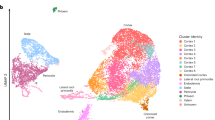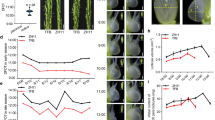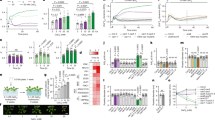Abstract
Silicon is beneficial to plant growth and helps plants to overcome abiotic and biotic stresses by preventing lodging (falling over) and increasing resistance to pests and diseases, as well as other stresses1,2,3. Silicon is essential for high and sustainable production of rice4, but the molecular mechanism responsible for the uptake of silicon is unknown. Here we describe the Low silicon rice 1 (Lsi1) gene, which controls silicon accumulation in rice, a typical silicon-accumulating plant. This gene belongs to the aquaporin family5 and is constitutively expressed in the roots. Lsi1 is localized on the plasma membrane of the distal side of both exodermis and endodermis cells, where casparian strips are located. Suppression of Lsi1 expression resulted in reduced silicon uptake. Furthermore, expression of Lsi1 in Xenopus oocytes showed transport activity for silicon only. The identification of a silicon transporter provides both an insight into the silicon uptake system in plants, and a new strategy for producing crops with high resistance to multiple stresses by genetic modification of the root's silicon uptake capacity.
This is a preview of subscription content, access via your institution
Access options
Subscribe to this journal
Receive 51 print issues and online access
$199.00 per year
only $3.90 per issue
Buy this article
- Purchase on Springer Link
- Instant access to full article PDF
Prices may be subject to local taxes which are calculated during checkout




Similar content being viewed by others
References
Epstein, E. The anomaly of silicon in plant biology. Proc. Natl Acad. Sci. USA 91, 11–17 (1994)
Ma, J. F. Role of silicon in enhancing the resistance of plants to biotic and abiotic stresses. Soil Sci. Plant Nutr. 50, 11–18 (2004)
Richmond, K. E. & Sussman, M. Got silicon? The non-essential beneficial plant nutrient. Curr. Opin. Plant Biol. 6, 268–272 (2003)
Savant, N. K., Snyder, G. H. & Datnoff, L. E. Silicon management and sustainable rice production. Advan. Agron. 58, 151–199 (1997)
Luu, D. T. & Maurel, C. Aquaporins in a challenging environment: molecular gears for adjusting plant water status. Plant Cell Environ. 28, 85–96 (2005)
Ma, J. F. & Takahashi, E. in Soil, Fertilizer, and Plant Silicon Research in Japan (Elsevier, Amsterdam, 2002)
Takahashi, E., Ma, J. F. & Miyake, Y. The possibility of silicon as an essential element for higher plants. Comments Agric. Food Chem. 2, 99–122 (1990)
Takahashi, E. & Hino, K. Silicon uptake by plants with special reference to the forms of dissolved silicon. J. Sci. Soil Manure Jpn 49, 357–360 (1978)
Raven, J. A. in Silicon in Agriculture (eds Datnoff, L. E., Snyder, G. H. & Korndörfer, G. H.) 41–55 (Elsevier, Amsterdam, 2001)
Tamai, K. & Ma, J. F. Characterization of silicon uptake by rice roots. New Phytol. 158, 431–436 (2003)
Casey, W. H., Kinrade, S. D., Knight, C. T. G., Rains, D. W. & Epstein, E. Aqueous silicate complexes in wheat, Triticum aestivum L. Plant Cell Environ. 27, 51–54 (2003)
Mitani, N., Ma, J. F. & Iwashita, T. Identification of silicon form in the xylem of rice (Oryza sativa L.). Plant Cell Physiol. 46, 279–283 (2005)
Yoshida, S. Chemical aspects of the role of silicon in physiology of the rice plant. Bull. Natl Inst. Agric. Sci. B 15, 1–58 (1965)
Fauteux, F., Remus-Borel, W., Menzies, J. G. & Belanger, R. R. Silicon and plant disease resistance against pathogenic fungi. FEMS Microbiol. Lett. 249, 1–6 (2005)
Ma, J. F., Tamai, K., Ichii, M. & Wu, K. A rice mutant defective in Si uptake. Plant Physiol. 130, 2111–2117 (2002)
Ma, J. F. et al. Characterization of Si uptake system and molecular mapping of Si transporter gene in rice. Plant Physiol. 136, 3284–3289 (2004)
Chaumont, F., Barrieu, F., Wojcik, E., Chrispeels, M. J. & Jung, R. Aquaporins constitute a large and highly divergent protein family in maize. Plant Physiol. 125, 1206–1215 (2001)
Ma, J. F., Goto, S., Tamai, K. & Ichii, M. Role of root hairs and lateral roots in silicon uptake by rice. Plant Physiol. 127, 1773–1780 (2001)
Taiz, L. & Zeiger, E. Plant Physiology 103–124 (Sinauer, Sunderland, 1998)
Hildebrand, M., Higgins, D. R., Busser, K. & Volcani, B. E. Silicon-responsive cDNA clones isolated from the marine diatom Cylindrotheca fusiformis. Gene 132, 213–218 (1993)
Hildebrand, M., Volcani, B. E., Gassmann, W. & Schroeder, J. I. A gene family of silicon transporters. Nature 385, 688–689 (1997)
Ma, J. F. Mechanism of Si uptake in plants. Fertilizer 94, 26–32 (2003)
Sripanyakorn, S., Jugdaohsingh, R., Thompson, R. P. H. & Powell, J. J. Dietary silicon and bone health. Nutr. Bull. 30, 222–230 (2005)
Ma, J. F., Higashitani, A., Sato, K. & Tateda, K. Genotypic variation in Si content of barley grain. Plant Soil 249, 383–387 (2003)
Hiei, Y., Ohta, S., Komari, T. & Kumashiro, T. Efficient transformation of rice (Oryza sativa L.) mediated by Agrobacterium and sequence analysis of the boundaries of the T-DNA. Plant J. 6, 271–282 (1994)
Helliwell, C. A., Wesley, S. V., Wielopolska, A. J. & Waterhouse, P. M. High-throughput vectors for efficient gene silencing in plants. Funct. Plant Biol. 29, 1217–1225 (2002)
Tallberg, P., Koski-Vahala, J. & Hartikainen, H. Germanium-68 as a tracer for silicon fluxes in freshwater sediment. Water Res. 36, 956–962 (2002)
Acknowledgements
This research was supported by a Grant-in-Aid for Scientific Research on Priority Areas from the Ministry of Education, Culture, Sports, Science and Technology of Japan (to J.F.M.) and a grant from the Ministry of Agriculture, Forestry and Fisheries of Japan (Rice Genome Project, to J.F.M.). Author Contributions K.T., N.Y. and N.M. contributed equally to this work. K.T. cloned the gene Lsi1, N.Y. investigated the localization of Lsi1, and N.M. measured the transport activity of Lsi1. J.F.M. performed the field and RNAi experiments and wrote the paper. All authors discussed the results and commented on the manuscript.
Author information
Authors and Affiliations
Corresponding author
Ethics declarations
Competing interests
The nucleotide sequence data reported in this paper has been deposited in the DDBJ/EMBL/GenBank nucleotide sequence databases under accession number AB222272. Reprints and permissions information is available at npg.nature.com/reprintsandpermissions. The authors declare no competing financial interests.
Supplementary information
Supplementary Figure 1
Modelling of Lsi1 protein by computer. (PDF 430 kb)
Supplementary Figure 2
Localization of mRNA of Lsi1 in lateral roots by in situ hybridization. (PDF 1320 kb)
Supplementary Figure 3
Subcellular localization of Lsi1. (PDF 876 kb)
Supplementary Figure 4
Cross section of rice root. (PDF 350 kb)
Supplementary Figure 5
Resistance to Ge toxicity of vector control and RNAi plant. (PDF 983 kb)
Rights and permissions
About this article
Cite this article
Ma, J., Tamai, K., Yamaji, N. et al. A silicon transporter in rice. Nature 440, 688–691 (2006). https://doi.org/10.1038/nature04590
Received:
Accepted:
Issue Date:
DOI: https://doi.org/10.1038/nature04590
This article is cited by
-
Plasma membrane intrinsic protein OsPIP2;6 is involved in root-to-shoot arsenic translocation in rice (Oryza sativa L.)
Plant Cell Reports (2024)
-
Current perspectives of ACR3 (arsenite efflux system) toward the reduction of arsenic accumulation in plants
Journal of Crop Science and Biotechnology (2024)
-
Preference of Silicon Accumulation on the Shade Foliage of Tree Crown and its Implication in Juniperus chinensis L.
Silicon (2024)
-
Is silicon beneficial for cassava (Manihot esculenta Crantz)?
Plant and Soil (2024)
-
Synergistic Effects of Selenium and Silicon Mitigate Arsenic Toxicity in Oryza sativa L.
Journal of Plant Growth Regulation (2024)
Comments
By submitting a comment you agree to abide by our Terms and Community Guidelines. If you find something abusive or that does not comply with our terms or guidelines please flag it as inappropriate.



